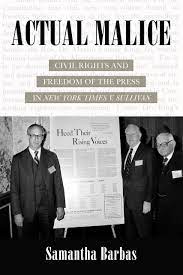

Samantha Barbas is Professor of Legal History and Director of the Baldy Center for Law and Social Policy at the University at Buffalo School of Law. This interview is based on her new book, Actual Malice: Civil Rights and Freedom of the Press in New York Times v. Sullivan (University of California Press, 2023).
JF: What led you to write Actual Malice?
SB: I wanted to write a comprehensive history of the 1964 Supreme Court First Amendment decision in New York Times v. Sullivan — a decision that is critically important for the protection of freedom of speech and press, and one that has been highly contested in recent years.
JF: In 2 sentences, what is the argument of Actual Malice?
SB: New York Times v. Sullivan has been traditionally described as a case about free speech and freedom of the press. In the book, I illustrate how Sullivan emerged from conflicts over civil rights in the 1960s and was as much about the civil rights movement as it was about freedom of speech.
JF: Why do we need to read Actual Malice?
SB: The dramatic story of the case — a story about how segregationists in the 1960s weaponized libel law to silence the civil rights movement and the press — makes clear why we need Sullivan’s protections for free speech and freedom of the press, and how libel law, in the absence of Sullivan, could be used to stifle dissent.
JF: Why and when did you become an American historian?
SB: I have been working in the field of American history since I started graduate school in history at the University of California, Berkeley, in 1996. One of the reasons I pursued the writing of history as a career is because I enjoy telling stories about people.
JF: What is your next project?
SB: I’m working on a cultural history of freedom of speech in the modern United States.
JF: Thanks, Samantha!